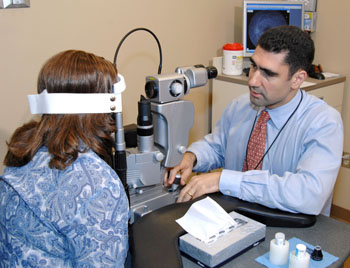
Franco Recchia, M.D., performs a laser procedure on patient Sharron Stinson at the Vanderbilt Eye Institute. (photo by Neil Brake)
Laser shines bright in study of macular edema treatments
The first study to compare the long-term effects of two macular edema treatments — a conventional laser procedure and a newer drug therapy — showed surprising results.
Investigators found that the newer drug therapy, the steroid triamcinolone, was less effective than the conventional laser treatment.
Also, after two years, the two main side effects — the need for cataract surgery and the incidence of an increased risk of glaucoma — were significantly higher in eyes treated with the steroid, while visual acuity was better in eyes treated with the laser.
Franco Recchia, M.D., associate professor and chief of the retina division at the Vanderbilt Eye Institute was among the principal investigators involved in what he calls “the most significant trial concerning diabetic retinopathy in 20 years.”
The study, set to appear in the September issue of Ophthalmology, showed that 51 percent of the steroid-treated group had cataract surgery compared with 13 percent of the laser-treated group.
Nearly half the steroid-treated group showed increased eye pressure and 28 percent experienced substantial vision loss, compared with 19 percent of the laser-treated group.
Macular edema, or retinal swelling, is the leading cause of visual impairment in people with diabetes. The retina is the delicate tissue composed of nerves and blood vessels that lines the inside of the back of the eye and is crucial for vision.
High blood sugar causes damage to the blood vessels that nourish the retina. The vessels may become fragile and leak fluid and proteins, causing blurry vision. Nearly 40 percent of people with diabetes develop irreversible vision loss.
For 25 years retinal specialists used the laser procedure to treat diabetic macular edema.
“We knew the traditional therapy was better than nothing in terms of reducing vision loss but was it truly the safest and the best option?” asked Recchia. “When word spread about the steroid injection's success, it was encouraging. Early reports justified a large scale clinical trial.
“As physicians we all were hopeful that another treatment option was on the horizon, but as an investigator you must take an objective approach.”
The multi-center trial, funded by the National Institutes of Health, enrolled a total of 693 patients.
Each patient was randomly assigned to either the conventional laser treatment or to one of two doses of the steroid.
Patients were re-evaluated every four months and were retreated if swelling persisted. If the condition worsened, a patient could switch from the initial treatment group into the other study arm.
Recchia said while the study showed steroid use early on was beneficial, continued use proved to be less effective and potentially harmful.
“This is precisely why this trial needed to be done,” he said. “We needed extended follow up. If we accepted the previous literature that studied patients for only six to nine months and saw that patients were getting better, we would have never learned that the effect was short-lived.
“This is a reminder to both patients and physicians that, while we are certainly aware of and looking to evaluate novel treatments, we also have to be critical of preliminary results and be wary of unequivocally embracing information before an important study can be done.”
Now investigators involved in the Diabetic Retinopathy Clinical Research Network, a coalition focused on multi-center clinical research, are conducting a study comparing a combination therapy using medicines and laser therapy versus laser treatment alone.













